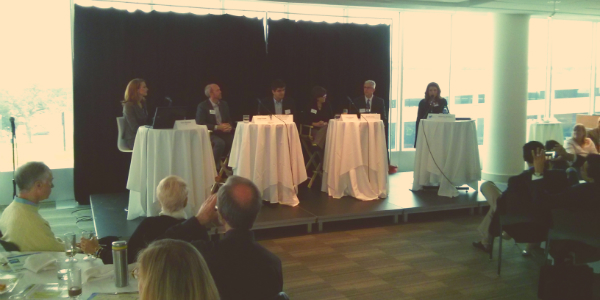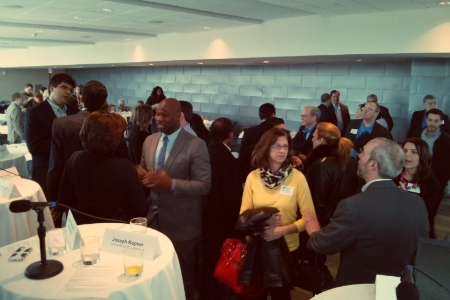
Guest post from 2013-14 Engage Breakfast Series guest blogger Alicia Dietrich. Alicia is a public affairs representative at the Harry Ransom Center at The University of Texas at Austin. See the end of this post for the podcast from the breakfast.
—–
Transportation—one of the largest issues facing the Greater Austin area today—was the topic of the day at the March 5 Engage breakfast panel “Beyond the Road: Mapping mobility options for Greater Austin.”
Panelists included CapMetro CEO Linda S. Watson; Scott Gross from the Austin Transportation Department and Project Connect: Central Corridor; Julio Gonzalez Altamirano, who writes about smart transit and land use on his blog Keep Austin Wonky; and Joseph Kopser, co-founder and CEO of mobility startup app RideScout.
With the rapid pace of population growth in Austin, panelists agreed that there is no single silver bullet to address the massive problem of clogged roads and congestion. However, panelists offered both a short-term and long-term look at what must be done for the city to evolve and accommodate the growth. Here are six major takeaways:
#1 – Building more roads won’t solve the issue.
“We’ve got 110 people moving to this area every single day,” said Watson. “They’re bringing 70 cars with them, and even if we were able to build additional roadways, they would fill up immediately.” Austin must take a multi-pronged approach that gives people more options with public transit, ridesharing, telecommuting, flex hours, bike lanes, and more.
#2 – People need to be more open-minded about getting out of their cars and experimenting with existing transit options.
“Only you can save yourself in your own daily commute,” said Kopser. He encouraged people to step outside their comfort zones and research ways to get out of their cars and utilize existing transportation options. For example, Kopser lives in Circle C and took a MetroRapid Bus from his neighborhood to downtown, picked up a bicycle from a bikeshare station at City Hall, and biked across the bridge to attend this breakfast event at the Long Center. His app RideScout aggregates options like buses, MetroRail, bikeshare programs, rideshares, cabs, etc. to streamline the research process. “Ask not what your city is going to do to fix your problem,” said Kopser. “Ask what you’re going to do to fix your own traffic problem.”

#3 – Employers can help by offering more flexibility in schedules and telecommuting options.
“It’s really easy—one day a week or one day every other week—to work from home or to carpool or to bike into work, and the reality is if you do it once a week, that’s a 20 percent reduction in your own commuting,” said Gross. “If everybody did that, we would have some real changes in town.” While the telecommuting rate in Austin is now 6 percent, the Austin Chamber of Commerce hopes to get that number up to 15 percent. Employers are also encouraged to offer flexible hours to help stagger the times of day when drivers are out on the roads. Kopser points out that a strong economic case can be made to company leaders that flexible options result in greater productivity as employees spend less time on the roads and have better focus since they’re not stressed out from a commute. “Every day, the American economy loses $140 million in lost productivity from only slight traffic problems,” said Kopser.
#4 – The planning process must be data-driven and accommodate high-density corridors.
Project Connect takes a 30-year view at where to make investments in transit and how they work together as a system. While the panelists may not agree about the best solutions to connect high-density corridors, they all agreed that obtaining accurate data and projections will be key to a successful transit system. “We’re having a spirited conversation right now about [where the planned metro rail route should go.],” said Altamirano. While people may disagree about location of the rail route, he said that it “is essential that we move forward together with the same facts because it is, as the Statesman reported, going to be a tough, uphill climb [to get voters to approve a bond measure for metro rail in the fall].”
#5 – Funding is Elephant in the Room #1
“No one at the federal, state, or local levels really has a good handle on how to continue raising revenue to invest in our infrastructure,” said Watson, “whether it’s maintaining what we’ve already got out there or increasing what we need to deal with our population growth. We just do not have a good plan at any level of the public sector.” She points out that the Federal Highway Trust Fund is bankrupt because gas tax revenue is down as cars become more efficient.
#6 – Density and land use is Elephant in the Room #2
Altamirano points out that in the past decade, some of the most popular neighborhoods in Austin’s core have actually seen a decline in population, which surprises many who hear nothing but news about Austin’s rapid growth. “That’s what policy failure looks like,” he said. “If you build too much too soon and you have bad land use at the core, you will push people out.” He said the land development code must be updated to help manage density in the core so that transit options can accommodate the core. Gross points to the Mueller development as a success story of updated land development that accommodates density in the core. “We have parts of Central Austin that are experiencing growth,” said Gross. “It’s just that there is a tension between density and preserving single-family neighborhoods.”
Full Audio from the Event
Download this audio file (MP3)